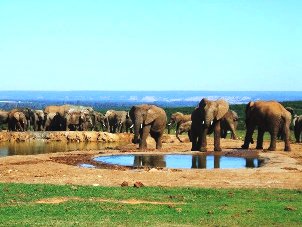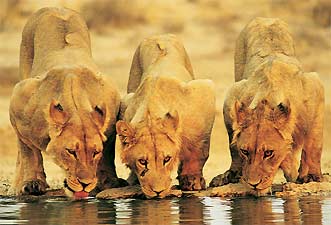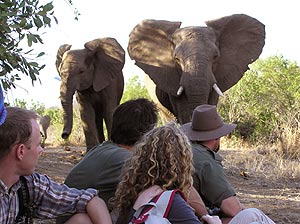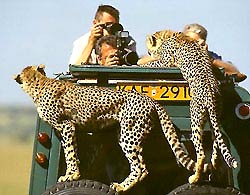
 So, you’ve made the critical decision and settled on a holiday in South Africa. It’s going to be brilliant. Cape Town is jaw-dropping, the beaches of the Cape Peninsula are beautiful (and more often than not virtually empty), the food is wonderful, the wine even better, and the Garden Route is a road-tripper’s dream.
So, you’ve made the critical decision and settled on a holiday in South Africa. It’s going to be brilliant. Cape Town is jaw-dropping, the beaches of the Cape Peninsula are beautiful (and more often than not virtually empty), the food is wonderful, the wine even better, and the Garden Route is a road-tripper’s dream.
This is only the tip of the proverbial iceberg. The Big Five will play a big part in every South Africa holiday, but trying to choose a safari really can be a hair-pulling, teeth-grinding affair. The South African safari market is ridiculously saturated (mainly because it is ridiculously lucrative) and there are so many options that it can be difficult to know where to begin.
The good news is that there all kinds of safaris out there – something for every budget and every kind of person (except perhaps those who don’t like animals). Whether you’re a backpacker or an investment banker, there is bound to be an ideal solution. It’s just a matter of knowing what’s available and what the jargon means in real, tangible terms.
Hopefully, this pocket guide will set you on the right track to your perfect South Africa safari:
WHERE TO GO ON SAFARI IN SOUTH AFRICA:
First, you’ll need to decide where to go:
1. There are no decent, ethical game reserves near Cape Town. Full stop.

 I used to work for an excellent South Africa safari specialist, and I lost count of the times that I was asked about safaris near Cape Town. It just isn’t possible. Yes, if you Google ‘safari near Cape Town’, you’ll come across a number of hits claiming to be Big Five game reserves a couple of hours outside Cape Town, but don’t listen to a word of it. Truly wild animals need space, probably around 5,000 hectares as a bare minimum, and none of the “game reserves” near Cape Town offer this kind of room to roam. If these reserves are indeed home to the Big Five, it probably means a couple of lions, usually within some kind of enclosure, a few elephants and some depressed giraffes. Basically, they amount to nothing more than glorified zoos. They are unethical and certainly fail to provide any kind of authentic safari feeling. You’re likely to leave feeling very sorry for the two overweight lions in their oversized cage who can’t be bothered to even raise their heads when your safari vehicle screeches up to a halt less than a metre away. I’ve seen it and I’m sufficiently scarred.
I used to work for an excellent South Africa safari specialist, and I lost count of the times that I was asked about safaris near Cape Town. It just isn’t possible. Yes, if you Google ‘safari near Cape Town’, you’ll come across a number of hits claiming to be Big Five game reserves a couple of hours outside Cape Town, but don’t listen to a word of it. Truly wild animals need space, probably around 5,000 hectares as a bare minimum, and none of the “game reserves” near Cape Town offer this kind of room to roam. If these reserves are indeed home to the Big Five, it probably means a couple of lions, usually within some kind of enclosure, a few elephants and some depressed giraffes. Basically, they amount to nothing more than glorified zoos. They are unethical and certainly fail to provide any kind of authentic safari feeling. You’re likely to leave feeling very sorry for the two overweight lions in their oversized cage who can’t be bothered to even raise their heads when your safari vehicle screeches up to a halt less than a metre away. I’ve seen it and I’m sufficiently scarred.
2. If you want a real bush safari experience, you need to head north.
Understandably, many holidaymakers to South Africa would prefer to fly in and out of Cape Town, by-passing the fabled badlands of Johannesburg altogether. However, not only is the area north of Johannesburg very beautiful indeed (Blyde River Canyon, God’s Window and more) but, unquestionably, the South Africa’s best safaris are found in Kruger National Park or Madikwe Game Reserve. These reserves are huge – Kruger, at over 2 million hectares, is about the size of Wales – and they feel really, truly, authentically wild. Madikwe is less visited and perfect for travellers eager to do something different. It hugs the border with Botswana and spans a massive 76,000 hectares – compare that to the 3,000 hectare “reserves” near Cape Town. It also has the advantage of being totally malaria free. Both Kruger and Madikwe are brilliant for really exciting safaris. It’s worth making the journey north if you’re passionate about wildlife, and you’re likely to see whole herds of animals doing what wild animals do – not just a lone rhino at a man-made watering hole.
3. The Eastern Cape can be a great compromise.

 Sometimes, getting up north just isn’t possible. If time is tight or you’ve got a whole family in tow, you could opt for a safari in the malaria-free Eastern Cape. Again, there are a host of options available, some far better than others. As ever, the bigger the game reserve, the more authentic the safari experience. Unfortunately, the curse of the Eastern Cape seems to be that you pay for each hectare through the nose.
Sometimes, getting up north just isn’t possible. If time is tight or you’ve got a whole family in tow, you could opt for a safari in the malaria-free Eastern Cape. Again, there are a host of options available, some far better than others. As ever, the bigger the game reserve, the more authentic the safari experience. Unfortunately, the curse of the Eastern Cape seems to be that you pay for each hectare through the nose.
Kwandwe and Shamwari (the setting for the BBC’s ‘Safari School’ programme) are both over 20,000 hectares and both the most expensive choices. Despite its size, I still found Shamwari fairly tame and spoilt by its own commercialism. There are just a couple too many lodges in the reserve, so you tend to come across other vehicles very regularly and the animals are found mainly by walkie-talkie contact between rangers rather than bushtracking. I saw the Big Five, but I didn’t get the big feeling.
Some of the smaller reserves in the Eastern Cape can actually provide a far warmer and more memorable safari experience. Bukela, in the Bushman’s conservancy, is a family-run lodge with game drives into the 8,000 hectare Amakhala Game Reserve. There’s a real community feeling here and you get far more sense of living remotely in the bush, even if it is low scrub rather than wild plains. Pumba (6500 hectares) is another small but lovely reserve, and Kariega (7,500) offers some really reasonably priced accommodation as well as horse-riding along the beach at Kenton-by-Sea.
Addo Elephant Park is definitely something not to be missed as you’re almost guaranteed to see dozens of elephants gathered around waterholes and crossing streams. Although technically a Big Five reserve, Addo is all about elephants, and you should combine it with another reserve if you really want to see lions as well. You can stay outside Addo in one of the beautiful guesthouses in the Sundays River Valley, such as Hitgeheim Lodge, surrounded by citrus orchards and ostriches and drive into the park with your own car during the day. Alternatively, all of the lodges and guesthouses in the area offer game drives into Addo with an experienced guide for an additional fee.
WHERE TO STAY ON SAFARI IN SOUTH AFRICA:
Next, you’ll need to choose what kind of accommodation you’re after. Here are a few hints about lodges and rest camps as well as what’s included and what’s not:
Private game reserves: Think glossy brochures, impeccable service, chocolates on the pillow and G&Ts at sunset. Private game reserves will provide the full safari works – one morning and one evening guided game drive (usually in an open top vehicle, with stops for morning coffee and sundowner cocktails), and all meals are included in the price. So, although the rates may seem gut-wrenchingly high, you can take comfort in the fact that you won’t spend much when you’re actually there (unless you have a penchant for vintage wines).

 You’ll find lots of exclusive reserves in what is known as Greater Kruger – Sabi Sands, Timbavati, Thornybush. Basically, these reserves are still part of Kruger, but privately owned. There are no fences between the land owned by these reserves and the public part of Kruger National Park, so the animals can wander between public and private at will. The really crucial thing is that the game rangers can go off-road in the private reserves, and really track the animals through the bush, while all game drives in public Kruger must stick strictly to the roads.
You’ll find lots of exclusive reserves in what is known as Greater Kruger – Sabi Sands, Timbavati, Thornybush. Basically, these reserves are still part of Kruger, but privately owned. There are no fences between the land owned by these reserves and the public part of Kruger National Park, so the animals can wander between public and private at will. The really crucial thing is that the game rangers can go off-road in the private reserves, and really track the animals through the bush, while all game drives in public Kruger must stick strictly to the roads.
Rest camps: These are the other end of the scale. Operated by South African National Parks (or SAN Parks), rest camps are the cheapie options in the public part of the Kruger, Addo Elephant, and other National Parks. Prices start very low indeed (a little over a tenner), and you can opt for camping, caravanning or one of the accommodation types available. These range from wooden chalets for 10 people to forest huts for 2 people, some with and some without private bathrooms but almost all with their very own braai (South Africa barbeque) set up outside. There will invariably be a kind of site-shop, so you can stock up on boerewors for dinner. If you love camping or getting close to the great outdoors, you’ll love it (I know I did!).
Safari-wise, it’s all about self-drive. You’ll get up early and scour the road network hoping to come across wildlife as you drive, and there’s nothing like the feeling of just happening upon a herd of elephants in your own car. It may not be off-roading, but it’s brilliant in other ways. One tip: If you’re planning on a rest camp safari, be sure to book really early because they fill up incredibly quickly – sometimes YEARS in advance.
Of course, you can always mix and match. Why not give yourselves a few nights in a basic forest hut before moving to a private reserve for some luxury and exclusive game drives. That really could get you the best of both safari worlds… and you won’t burn a hole in your pocket the size of the Fish River Canyon!
Fingers crossed that this information will inch you closer to the right safari and there are some great you South Africa travel specialists out there. South Africa is just wonderful, and however you choose to do it, you’re sure to have a pretty unbeatable experience.